Introduction to Mindful Movement Pilates: Elevating Your Fitness and Well-Being
In this article, we will delve into mindful movement Pilates, exploring how this transformative practice can enhance your physical and mental well-being while revolutionizing your approach to fitness.
Imagine this: you’re lying on a mat in a quiet room, sunlight streaming through the windows, feeling every muscle in your body as you move with intention and awareness. This isn’t just a workout; it’s a transformative experience that brings together the best of physical exercise and mental clarity. This is the essence of mindful movement Pilates. Combining the structured, precise movements of Pilates with the deep, focused awareness of mindfulness creates a unique practice that can elevate your fitness routine to new heights.
Pilates has long been celebrated for its ability to strengthen the core, improve flexibility, and enhance overall body awareness. However, when you integrate mindfulness into your Pilates practice, you unlock a whole new level of benefits. Mindful movement Pilates is not just about going through the motions; it’s about being fully present in each movement, feeling every muscle, and connecting your breath to your body’s actions. This mindful approach can transform your Pilates sessions from a simple exercise routine into a holistic experience that nurtures both your body and mind.
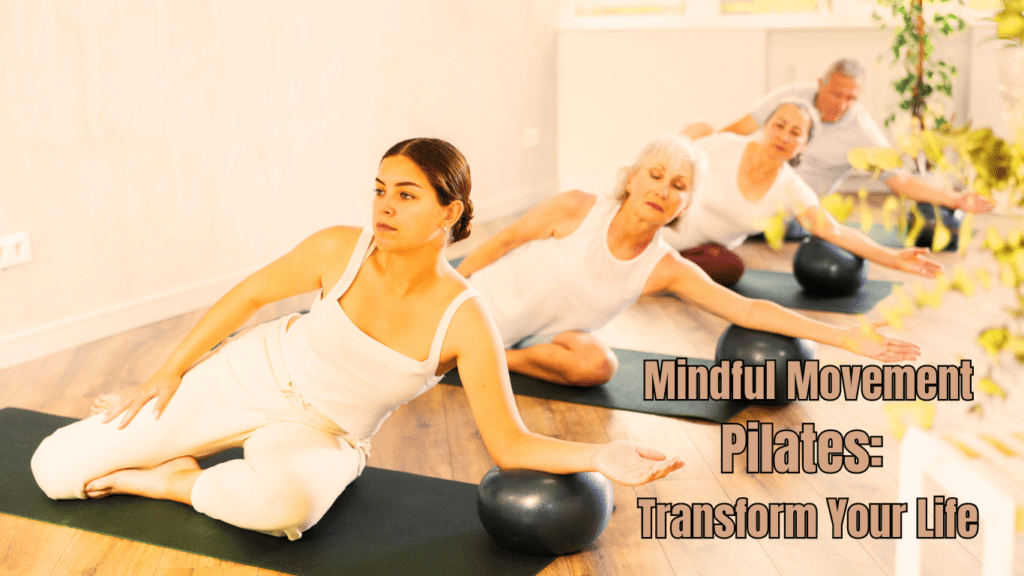
Integrating mindfulness into Pilates offers a myriad of benefits. First and foremost, it enhances your physical well-being. When you are fully present during your workout, you’re more likely to perform each exercise with proper form and alignment, reducing the risk of injury and maximizing the effectiveness of each movement. In mindful movement Pilates, you pay close attention to your body’s signals, adjusting as needed to ensure that you’re engaging the right muscles and maintaining good posture. This heightened body awareness helps you build strength and flexibility more efficiently, as you’re not simply going through the motions but are actively involved in every aspect of your workout.
But the benefits of mindful movement Pilates extend beyond the physical. By incorporating mindfulness into your Pilates practice, you also cultivate a deeper sense of mental clarity and emotional balance. The focus required to stay present in each moment helps to quiet the mind, reducing stress and anxiety. As you concentrate on your breath and the sensations in your body, you create a space where you can let go of the worries and distractions of daily life. This mental break is not only refreshing but also rejuvenating, leaving you feeling more centered and calm after your workout.
Subscribe And Get Our Free E-Book:Unlocking The Power Of Nutrition-Supplements, Substitutes, and Superfoods!
One of the key aspects of mindful movement Pilates is the emphasis on the breath. In traditional Pilates, breath control is already a fundamental component, used to facilitate movement and enhance core engagement. When mindfulness is added to the mix, this focus on the breath becomes even more powerful. By paying attention to your breath, you can synchronize it with your movements, creating a seamless flow that enhances your practice. Each inhale and exhale becomes a cue to move with intention, deepening the connection between your mind and body.
Another significant benefit of integrating mindfulness into Pilates is the improvement in mental resilience. Practicing mindfulness teaches you to stay present and focused, even when faced with challenging exercises or distractions. This ability to maintain concentration and stay grounded can translate to other areas of your life, helping you to handle stress and adversity more effectively. The discipline and mental fortitude developed through mindful movement Pilates can empower you to approach life’s challenges with a calm and centered mindset.
Moreover, mindful movement Pilates encourages a greater appreciation for your body and its capabilities. Instead of focusing solely on achieving a particular physique or reaching specific fitness goals, mindfulness shifts your attention to the experience of moving and the sensations in your body. This shift in focus can lead to a more positive body image and a healthier relationship with exercise. By appreciating what your body can do and how it feels, rather than how it looks, you cultivate a sense of gratitude and respect for your physical self.
Mindful Pilates is a powerful practice that combines the best of both worlds: the physical benefits of Pilates and the mental clarity of mindfulness. By bringing mindfulness into your Pilates routine, you can enhance your physical performance, reduce stress, and improve your overall well-being. Whether you’re a seasoned Pilates enthusiast or a newcomer to the practice, incorporating mindfulness can elevate your workouts and transform your approach to fitness. So next time you roll out your mat, remember to move with intention, breathe with awareness, and embrace the full experience of mindful movement Pilates.
What is Mindful Movement in Pilates?
Mindful movement Pilates is about blending the physical practice of Pilates with the mental clarity of mindfulness. This approach transforms your Pilates sessions into a holistic experience that not only strengthens your body but also nurtures your mind. Incorporating mindful movement into Pilates means being fully present during your workout, focusing on each movement, and connecting your breath with your body’s actions. It’s about moving with intention and awareness, which can significantly enhance the benefits of your practice.
Pilates, developed by Joseph Pilates in the early 20th century, was initially called “Contrology.” Joseph Pilates designed this system to improve physical strength, flexibility, and posture, emphasizing controlled movements and core strength. The integration of mindfulness into Pilates is a more recent development, aligning perfectly with the practice’s original principles. Mindfulness, rooted in ancient meditation practices, involves paying attention to the present moment without judgment. When combined with Pilates, it creates a powerful practice that enhances both physical and mental well-being.
Pilates Mindfulness Video
The core principles of mindful movement Pilates draw from both mindfulness and traditional Pilates. One of the major principles is body awareness. In Pilates, you focus on the precise execution of movements. When you add mindfulness, this focus deepens, making you acutely aware of every muscle engagement and movement pattern. This heightened body awareness ensures that you perform each exercise with proper form, reducing the risk of injury and maximizing the effectiveness of your workout.
Breath control is another essential principle. In Pilates, breath is used to facilitate movement and engage the core muscles. Mindfulness takes this a step further by encouraging you to synchronize your breath with your movements, creating a harmonious flow. This mindful breathing not only enhances physical performance but also calms the mind, reducing stress and promoting relaxation.
Concentration is a key aspect of both mindfulness and Pilates. Pilates exercises require focus to perform correctly, and mindfulness strengthens this focus by training your mind to stay present. This combination helps you maintain concentration throughout your workout, ensuring that you get the most out of each session.
Centering is also fundamental to mindful movement Pilates. This principle refers to focusing on the core, or “powerhouse,” of the body. By concentrating on the muscles of the abdomen, lower back, and pelvis, you build a strong foundation for all movements. Mindfulness enhances this by encouraging you to stay centered mentally, helping you to maintain balance and stability in both your body and mind.
Control is at the heart of Pilates. Every movement is performed with precision and control, avoiding jerky or haphazard actions. Mindfulness amplifies this control by fostering a calm and focused mind, allowing you to move with greater precision and purpose.
Precision is another crucial principle. Pilates emphasizes the importance of performing each movement accurately. Mindfulness helps you to pay attention to the details, ensuring that every exercise is executed with the utmost care and correctness. This attention to detail not only improves the quality of your workout but also helps you develop better body mechanics and alignment.
Flow is about moving smoothly and gracefully from one exercise to the next. In Pilates, movements are designed to be fluid and continuous. Mindfulness enhances this flow by helping you stay present and connected to your body, creating a seamless and enjoyable workout experience.
Incorporating mindful movement into Pilates also involves mindful listening. This means tuning in to your body’s signals and responding appropriately. If you feel tension or discomfort, mindfulness encourages you to adjust your movements or take a break, preventing strain and injury. This approach fosters a respectful and compassionate relationship with your body, promoting long-term health and well-being.
The origins of Pilates are deeply rooted in the idea of using controlled, intentional movement to improve overall health. Joseph Pilates believed that physical and mental health were interconnected, a concept that aligns perfectly with mindfulness. By integrating mindfulness into Pilates, you are honoring this original vision, creating a practice that is as beneficial for the mind as it is for the body.
Mindful movement Pilates is more than just a workout; it’s a practice that fosters a deeper connection between your mind and body. It encourages you to move with awareness, listen to your body, and be present in each moment. This approach can transform your Pilates sessions into a meditative experience, helping you achieve greater physical strength, flexibility, and mental clarity.
Mindful movement Pilates combines the physical benefits of Pilates with the mental clarity of mindfulness. By incorporating principles such as body awareness, breath control, concentration, centering, control, precision, flow, and mindful listening, you create a practice that enhances both your physical and mental well-being. Whether you’re new to Pilates or a seasoned practitioner, integrating mindfulness into your routine can elevate your workouts and enrich your overall fitness experience. So next time you practice Pilates, remember to move with intention, breathe with awareness, and embrace the full experience of mindful movement Pilates.
Benefits of Practicing It
Practicing mindful movement Pilates brings a host of benefits that extend beyond the physical realm, positively influencing mental and overall well-being. This approach enhances the traditional Pilates practice by encouraging a deeper connection between the mind and body, resulting in a more effective and fulfilling workout experience.
Physical benefits of mindful movement Pilates are profound. When you engage in Pilates with mindfulness, you are more aware of your body’s alignment and movements, which can significantly improve your strength, flexibility, and posture. As you focus on each movement, ensuring precision and control, you activate and engage the correct muscles. This heightened awareness helps to prevent injury by promoting proper form and alignment, ensuring that you get the most out of every exercise. For instance, when performing a plank or a roll-up, being mindful of your core engagement and spinal alignment can maximize the effectiveness of these exercises, building core strength and enhancing overall muscle tone.
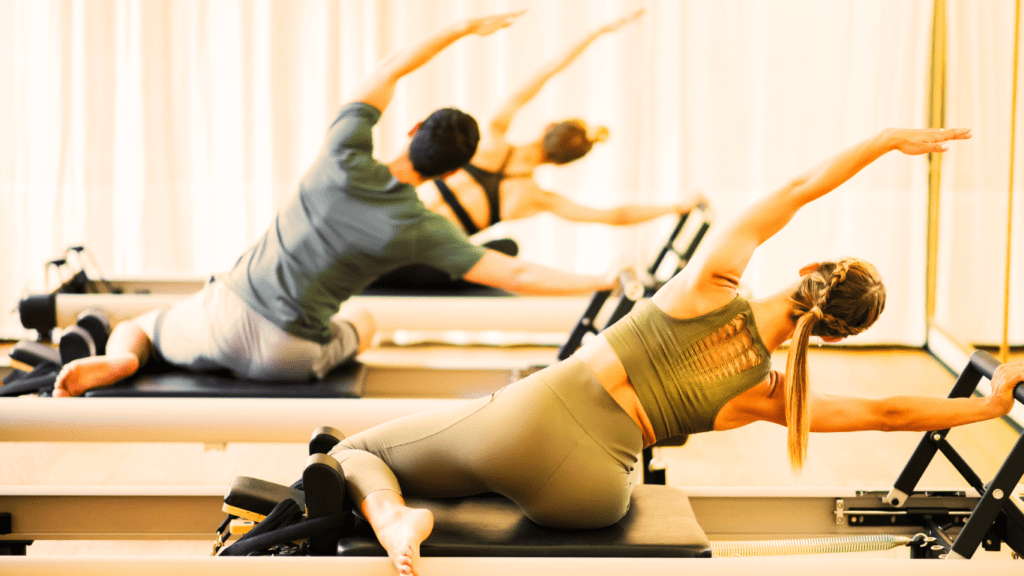
Flexibility is another key physical benefit. Mindful movement Pilates encourages you to pay attention to how your body feels as you stretch and move. This awareness helps you to gently push your boundaries, improving your flexibility over time. By focusing on the breath and easing into stretches mindfully, you can gradually increase your range of motion without straining or overextending. This mindful approach to stretching ensures that you develop flexibility in a safe and sustainable way.
Posture is also greatly enhanced through mindful movement Pilates. By being conscious of your body’s alignment and making adjustments as needed, you cultivate better posture both during your workouts and in everyday life. This improved posture not only makes you look more confident and poised but also reduces the risk of back and neck pain, contributing to long-term spinal health. Mindfulness teaches you to be aware of your posture throughout the day, reminding you to stand tall and align your spine properly.
The mental benefits of mindful movement Pilates are equally significant. One of the most notable is the reduction of stress. The focus required to practice Pilates mindfully helps to quiet the mind, providing a mental break from the worries and distractions of daily life. As you concentrate on your breath and the sensations in your body, you enter a state of relaxation and calm. This stress reduction can lead to improved sleep, better mood, and a greater sense of overall well-being.
Improved focus is another key mental benefit. Mindful movement Pilates trains your mind to stay present and engaged, enhancing your ability to concentrate. This improved focus can extend beyond your Pilates sessions, helping you to stay attentive and productive in other areas of your life. Whether you’re at work, studying, or engaging in hobbies, the mental discipline cultivated through mindful movement can enhance your performance and satisfaction.
Emotional balance is also fostered through mindful movement Pilates. The practice encourages you to tune into your emotions and observe them without judgment. This mindfulness can help you to better understand and manage your emotions, leading to greater emotional resilience. By acknowledging your feelings and responding to them with compassion, you cultivate a healthier relationship with yourself and others. This emotional balance contributes to a more harmonious and fulfilling life.
The holistic benefits of integrating mindful movement into Pilates are perhaps the most transformative. By connecting body and mind, you create a practice that nurtures your entire being. This holistic approach leads to overall better health and life satisfaction. When you practice mindful movement Pilates, you’re not just working out; you’re engaging in a form of self-care that supports your physical, mental, and emotional well-being.
This integration of body and mind fosters a deeper sense of self-awareness. As you become more attuned to your body’s needs and responses, you develop a greater appreciation for your body and its capabilities. This self-awareness promotes a positive body image and a healthier relationship with exercise, shifting the focus from external appearance to internal experience. You learn to value how your body feels and functions, rather than how it looks, leading to a more positive and sustainable approach to fitness.
Mindful movement Pilates also encourages a more balanced lifestyle. By promoting relaxation and stress reduction, it helps to counteract the negative effects of a hectic and demanding life. This balance extends to your overall lifestyle choices, encouraging healthier habits and greater self-care. As you become more mindful, you may find yourself making better choices regarding nutrition, sleep, and other aspects of your health, leading to a more balanced and fulfilling life.
The benefits of practicing mindful movement Pilates are extensive and multifaceted. Physically, it enhances strength, flexibility, and posture. Mentally, it reduces stress, improves focus, and fosters emotional balance. Holistically, it integrates body and mind, leading to overall better health and life satisfaction. By incorporating mindfulness into your Pilates practice, you create a powerful and transformative experience that nurtures your entire being. Whether you’re looking to improve your physical fitness, enhance your mental clarity, or achieve a more balanced and fulfilling life, mindful movement Pilates offers a comprehensive approach to wellness that can help you achieve your goals. So, next time you roll out your mat, remember to move with intention, breathe with awareness, and embrace the full experience of mindful movement Pilates.
Chart: Enhancing Your Pilates Practice with Mindfulness
| Aspect | Traditional Pilates | Mindful Movement Pilates | New Insights |
|---|---|---|---|
| Focus | Core strength, flexibility, posture | Core strength, flexibility, posture, and mindfulness | Integrates mental clarity and body awareness into each movement |
| Breath Control | Facilitates movement and engages core muscles | Synchronizes breath with movement for a fluid experience | Enhanced breath control improves overall practice flow |
| Body Awareness | Focus on muscle engagement and alignment | Deepens awareness of every muscle and movement | Increased body awareness helps prevent injuries and optimize performance |
| Mental Clarity | Not a primary focus | Reduces stress, cultivates emotional balance | Mindful approach provides mental relaxation and clarity |
| Emotional Benefits | Limited focus on emotional well-being | Greater emotional resilience and balance | Improved emotional regulation through mindfulness practice |
| Physical Benefits | Strength, flexibility, and improved posture | All physical benefits of Pilates plus enhanced body awareness | Enhanced physical results due to more precise and intentional movements |
| Principles | Precision, control, flow | Precision, control, flow, plus mindfulness | Mindfulness adds a new layer to traditional principles, enhancing overall effectiveness |
| Practice Environment | General setup focus on comfort and functionality | Quiet, clutter-free space with calming elements | Creates an optimal environment for combining physical and mental practices |
| Exercises | Focus on correct execution and form | Emphasizes correct execution with added mindfulness | Exercises are performed with heightened awareness and intention, enhancing their impact |
| Posture Awareness | Aimed at improving posture during workouts | Continuous awareness of posture in daily life | Mindfulness helps maintain good posture beyond the mat, improving overall spinal health |
| Self-Care | Limited emphasis | Encourages a positive body image and appreciation | Shifts focus from appearance to functional appreciation of the body |
How to Practice Pilates with Mindful Movement
Practicing Pilates with mindful movement transforms your workout into a holistic experience that enhances both physical and mental well-being. To effectively integrate mindfulness into your Pilates practice, it’s essential to prepare your space, understand the equipment needed, and employ specific mindfulness techniques throughout your routine.
Preparation is key to a successful mindful movement Pilates session. Start by setting up your space in a way that promotes focus and relaxation. Choose a quiet, clutter-free area where you can move freely without distractions. Dim lighting and calming music can create a soothing atmosphere conducive to mindfulness. Ensure your mat is clean and comfortable, providing a stable surface for your exercises.
The equipment needed for mindful movement Pilates is minimal but can enhance your practice. A Pilates mat is essential for cushioning and support during floor exercises. Additional props such as resistance bands, Pilates balls, or small weights may be used to add variety and challenge to your workouts. These tools can assist in modifying exercises to suit your fitness level and goals, facilitating a more effective and engaging practice.
Mindfulness techniques are integral to practicing mindful movement Pilates. Begin by focusing on your breath. In Pilates, breath is used to initiate and support movement, promoting core engagement and stability. Incorporate mindful breathing techniques such as diaphragmatic breathing or deep belly breathing to enhance relaxation and oxygenation of muscles. Coordinate your breath with each movement, inhaling deeply to prepare and exhaling fully to engage muscles and release tension.
Body awareness is another essential mindfulness technique in Pilates. Tune into the sensations and alignment of your body as you perform each exercise. Pay attention to how your muscles contract and lengthen, ensuring proper form and alignment. Use visualizations or mental cues to connect with specific muscle groups, enhancing your awareness and control throughout the movement.
Now, let’s explore a series of basic Pilates exercises with added mindfulness instructions to deepen your practice:
- Pelvic Curl: Lie on your back with knees bent, feet hip-width apart. Inhale to prepare. Exhale, imprint your spine into the mat, and peel your spine off the mat sequentially, vertebra by vertebra. Inhale at the top, maintaining a neutral pelvis. Exhale as you roll down through your spine, articulating each vertebra back onto the mat. Focus on the sensation of each vertebra touching the mat, engaging your core throughout.
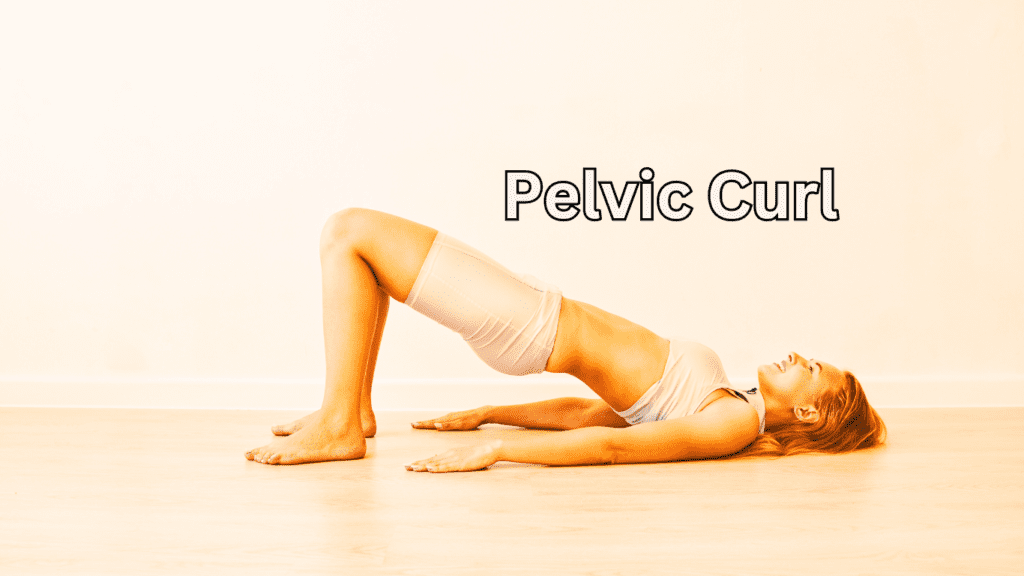
- Hundreds: Lie on your back, legs in tabletop position, arms extended by your sides. Inhale to prepare. Exhale, lift your head and shoulders off the mat, curling your chin towards your chest. Begin to pump your arms up and down with breath: inhale for 5 counts, exhale for 5 counts. Maintain a strong core and stable pelvis throughout. Focus on your breath pattern and the rhythm of your arm pumps.
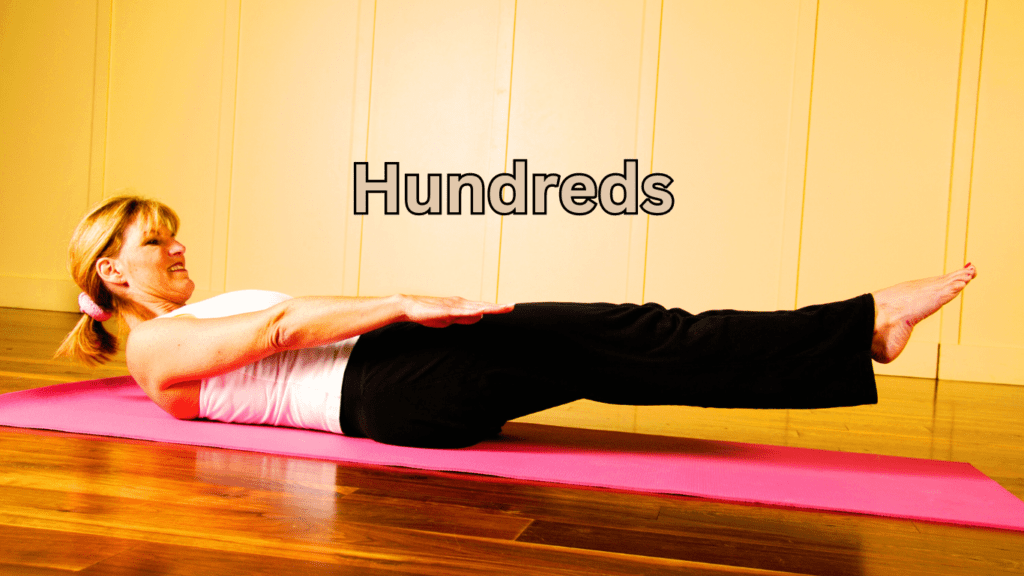
- Single Leg Stretch: Lie on your back, knees hugged into chest, head and shoulders lifted off the mat. Inhale to prepare. Exhale, extend your right leg out to a 45-degree angle as you simultaneously switch legs, bringing the left knee towards your chest. Inhale to switch, exhale to switch. Maintain a stable torso and engage your abdominals to control the movement. Focus on the lengthening of your extended leg and the contraction of your abdominals.
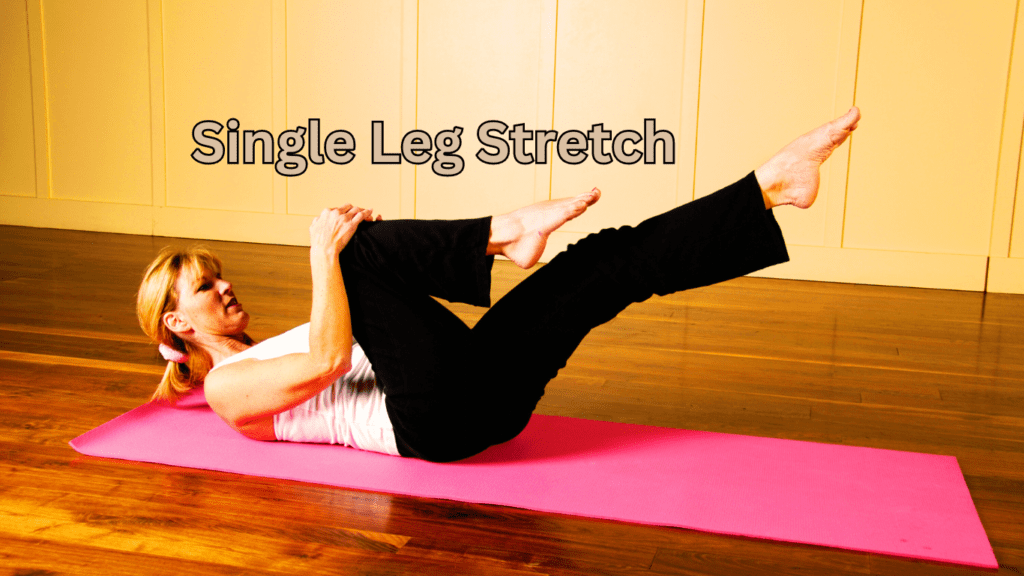
- Side-Lying Leg Series: Lie on your side with your bottom arm extended and head resting on it. Legs are straight and stacked on top of each other. Inhale to prepare. Exhale, lift your top leg to hip height, keeping your pelvis stable. Inhale, lower the leg with control. Focus on the activation of your outer hip and the stability of your core. Engage your inner thighs to maintain alignment throughout the movement.
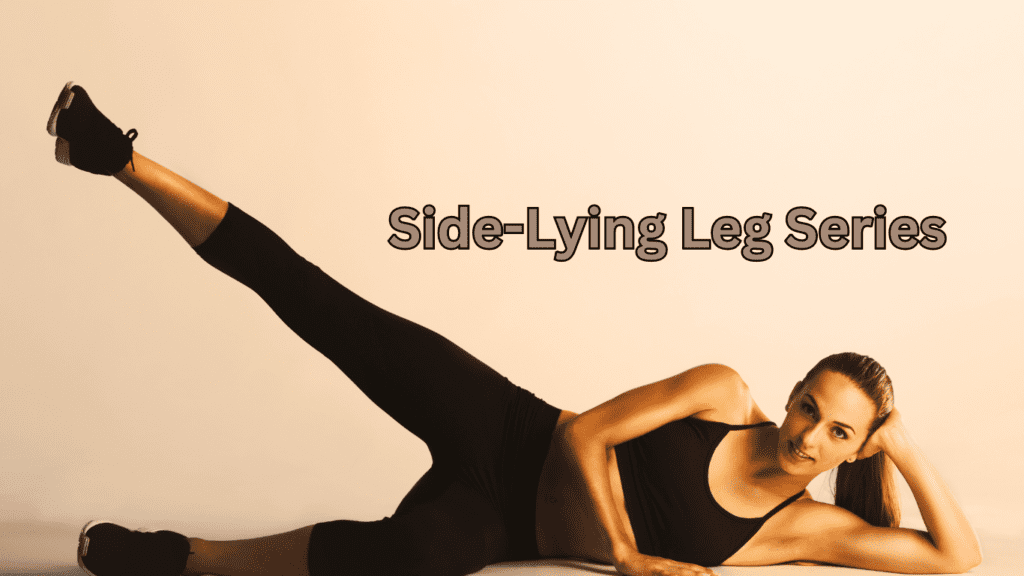
- Plank: Begin in a forearm plank position, elbows directly under shoulders, legs extended behind you, and toes tucked under. Inhale to prepare. Exhale, engage your core and lift your hips to align with your shoulders and heels. Hold the position, focusing on maintaining a neutral spine and strong abdominal engagement. Breathe deeply and evenly throughout the hold, maintaining mindfulness of your body alignment and muscle engagement.
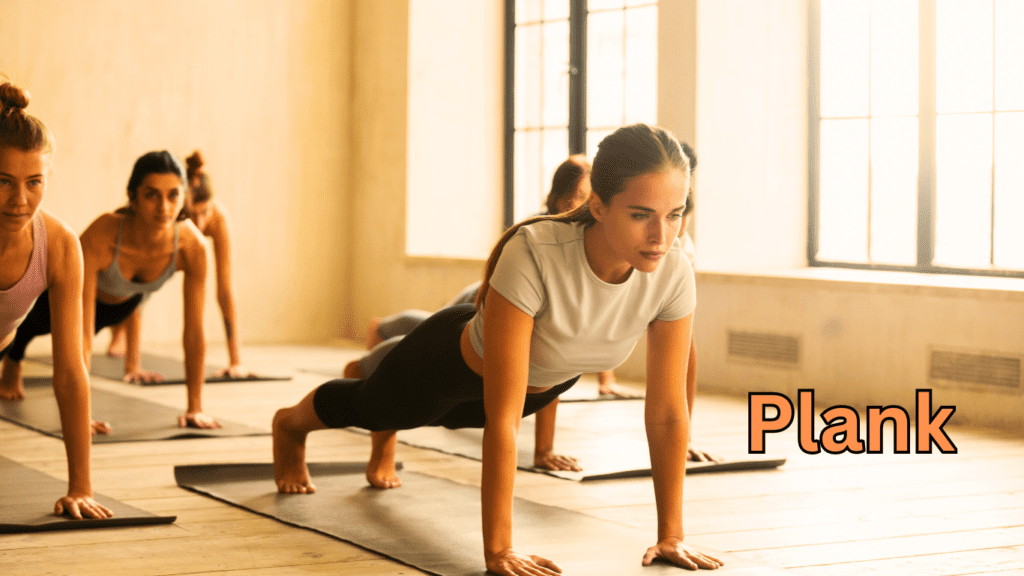
To maintain a mindful state during each exercise, continuously check in with your body and breath. Notice any areas of tension or discomfort, and adjust as needed to ensure you’re moving with ease and control. Avoid rushing through the exercises; instead, move deliberately and with intention, maintaining a steady rhythm of breath and movement.
Incorporating mindfulness into your Pilates practice enhances not only the physical benefits but also the mental clarity and overall enjoyment of your workouts. By practicing with mindful movement, you cultivate a deeper connection between your mind and body, promoting better alignment, strength, flexibility, and emotional well-being. Whether you’re new to Pilates or a seasoned practitioner, integrating these mindfulness techniques can elevate your practice and enrich your overall fitness journey. So, next time you step onto your mat, remember to breathe deeply, move with awareness, and embrace the transformative power of mindful movement Pilates.
Creating a Routine
Creating a routine with mindful movement Pilates is a personalized journey that allows you to tailor your practice to your individual needs and goals. By incorporating mindfulness into your Pilates routine, you can cultivate a deeper connection between your mind and body while achieving physical fitness and mental clarity.
Personalization is key when establishing a mindful movement Pilates routine. Consider your current fitness level, any specific health concerns, and your personal goals. Whether you’re aiming to improve core strength, enhance flexibility, alleviate back pain, or simply reduce stress, customize your routine to prioritize these objectives. Modify exercises as needed to accommodate any physical limitations or challenges, ensuring that your practice is safe and effective for you.
When creating your routine, it’s essential to maintain consistency. Regular practice is crucial for reaping the benefits of mindful movement Pilates. Aim for consistency in both frequency and duration of your sessions. Start with realistic goals, such as practicing Pilates three times a week for 30 minutes, and gradually increase as your fitness level improves. Establish a routine that fits into your daily schedule, whether it’s in the morning before work, during a lunch break, or in the evening as a wind-down from the day.
To help track your progress and stay motivated, consider using various methods to monitor your achievements. Keep a journal or logbook to record your workouts, noting the exercises performed, repetitions, and any observations or reflections. This journal can serve as a valuable tool for tracking improvements in strength, flexibility, and overall well-being over time. Celebrate your milestones, no matter how small, to maintain motivation and momentum in your practice.
Setting short-term and long-term goals can also help you stay focused and committed to your mindful movement Pilates routine. Short-term goals may include mastering a specific Pilates exercise or improving flexibility in a particular muscle group. Long-term goals could involve achieving overall fitness milestones, such as increasing core strength or maintaining consistent practice for several months. Break down larger goals into smaller, achievable steps, and celebrate each accomplishment along the way.
Consistency in your mindfulness practice is equally important. Mindful movement Pilates encourages you to stay present and fully engaged during each exercise. Cultivate mindfulness by focusing on your breath, observing sensations in your body, and maintaining awareness of your movements and alignment. Practice non-judgmental awareness, allowing thoughts to come and go without attaching to them. This mindful approach enhances the overall quality of your Pilates practice, fostering a deeper mind-body connection and promoting relaxation.
To build and maintain consistency in your mindful movement Pilates routine, establish a dedicated space for practice that promotes focus and relaxation. Choose a quiet environment free from distractions, with ample room to move comfortably. Consider incorporating soothing music or natural lighting to create a calming atmosphere conducive to mindfulness.
Another strategy for consistency is to establish a routine that fits seamlessly into your daily schedule. Determine the best time of day for your Pilates practice based on your energy levels and availability. Whether it’s early morning, midday, or evening, prioritize your practice as an essential part of your self-care routine. By making Pilates a consistent habit, you reinforce its importance in your daily life and set yourself up for long-term success.
Tracking your progress in mindful movement Pilates can provide valuable feedback and motivation. Keep a journal or logbook to record your workouts, noting the exercises performed, duration, and any observations or reflections. Track changes in your strength, flexibility, and overall well-being over time. Celebrate your achievements, whether it’s mastering a challenging exercise, improving flexibility, or maintaining a consistent practice schedule.
Setting clear and achievable goals can help you stay focused and motivated in your mindful movement Pilates journey. Define specific objectives that align with your personal fitness and well-being aspirations. Whether it’s increasing core strength, improving posture, or reducing stress, establish milestones that inspire and challenge you. Break down larger goals into smaller, manageable steps, and celebrate each accomplishment along the way.
Creating a routine with mindful movement Pilates is a transformative journey that promotes physical fitness, mental clarity, and overall well-being. By personalizing your practice, maintaining consistency, and tracking your progress, you can cultivate a deeper connection between your mind and body while achieving your health and fitness goals. Whether you’re new to Pilates or a seasoned practitioner, integrating mindfulness into your routine enhances the quality and effectiveness of your workouts, leading to greater resilience, balance, and satisfaction in your life. Embrace the opportunity to nurture your body and mind through mindful movement Pilates, and enjoy the journey of self-discovery and growth.
Mindful Movement Pilates Success Blueprint Chart
| Step/Strategy | Description | Implementation Tips | Expected Outcome |
|---|---|---|---|
| 1. Define Personal Goals | Identify what you want to achieve with Pilates, such as core strength or stress reduction. | – Write down specific short-term and long-term goals.<br>- Align goals with personal needs and interests. | Clear focus and motivation for your practice. |
| 2. Personalize Routine | Tailor exercises to fit your fitness level, health concerns, and goals. | – Start with beginner exercises if new.<br>- Modify exercises based on physical limitations. | More effective and safer practice. |
| 3. Establish Consistency | Set a regular schedule for your Pilates sessions. | – Choose a time that fits your daily routine.<br>- Start with manageable frequency, e.g., 3 times a week. | Enhanced habit formation and steady progress. |
| 4. Track Progress | Use a journal or logbook to monitor your achievements and changes over time. | – Record details of each session.<br>- Note improvements and challenges. | Better self-awareness and motivation. |
| 5. Set Up Practice Environment | Create a dedicated, distraction-free space for your sessions. | – Select a quiet area.<br>- Use calming elements like soft lighting or music. | Improved focus and relaxation during practice. |
| 6. Overcome Challenges | Address common obstacles with practical solutions. | – Start slowly to accommodate physical limitations.<br>- Use breathing techniques for mindfulness. | Reduced frustration and improved practice effectiveness. |
| 7. Seek Guidance | Consider working with a certified instructor for personalized feedback. | – Look for recommendations or reviews.<br>- Engage in regular sessions for expert guidance. | Correct technique and personalized adjustments. |
| 8. Celebrate Milestones | Recognize and celebrate your achievements, no matter how small. | – Set up reward systems for reaching goals.<br>- Reflect on progress regularly. | Increased motivation and satisfaction in practice. |
| 9. Adapt as Needed | Be flexible with your routine based on your evolving needs and experiences. | – Modify your routine based on physical and emotional states.<br>- Experiment with different times or exercises. | Enhanced enjoyment and continued progress. |
How to Use This Blueprint:
- Start with Goal Definition: Clearly outline what you want to achieve with your Pilates practice.
- Personalize Your Routine: Customize your exercises and schedule to fit your individual needs.
- Ensure Consistency: Establish a regular practice schedule to build a strong habit.
- Track and Reflect: Use a journal to monitor your progress and make adjustments as needed.
- Optimize Your Environment: Create a conducive space for your practice to maximize focus and relaxation.
- Address Challenges: Implement practical solutions to overcome common obstacles in your practice.
- Seek Professional Help: Engage with a Pilates instructor to refine your technique and receive personalized guidance.
- Celebrate and Adapt: Acknowledge your achievements and be flexible with your routine to maintain motivation and satisfaction.
Success Story
“Let me tell you about Briana—a woman whose journey with Pilates is nothing short of remarkable and deeply inspiring. In the quiet suburbs where she lived, Briana’s days were consumed with the duties of a devoted homemaker. Yet, beneath her seemingly ordinary life, she battled with weight gain and struggled with self-esteem issues.
Her marriage, once filled with love and promise, had gradually grown distant and strained under the weight of unspoken frustrations. It was during this challenging time that Briana’s path crossed with Pilates—a practice that blends physical exercise with mindfulness. Introduced to Pilates by a friend, Briana hesitantly stepped into her first class, unsure of what to expect but hopeful for change.
From the very first session, Briana felt a shift within herself. Pilates wasn’t just about movements; it was a journey of self-discovery and empowerment. With each stretch and breath, she found herself reconnecting with her body in ways she hadn’t in years. The practice of mindfulness in Pilates allowed her to quiet her mind, release tension, and focus on the present moment.
As weeks turned into months, Briana’s dedication to Pilates began to yield profound changes. Physically, she grew stronger, more flexible, and more toned. But the transformation wasn’t merely physical. Pilates became a lifeline—a sanctuary where Briana could center herself amidst life’s challenges. It gave her a sense of control and confidence she had longed for.
Through consistent practice and perseverance, Briana not only regained her physical health but also revitalized her emotional well-being. The weight of self-doubt and insecurity lifted, replaced by a newfound sense of self-worth and resilience. She approached challenges in her marriage and personal life with a newfound clarity and determination.
Pilates didn’t just transform Briana’s body; it transformed her entire outlook on life. It became more than a workout routine; it became a philosophy—a way of living mindfully and purposefully. Briana’s story is a testament to the power of mindful movement and its ability to heal, strengthen, and empower.
Today, Briana continues to practice Pilates, not just for its physical benefits but for the profound sense of well-being it brings her. Her journey serves as a source of inspiration for those around her, illustrating that with dedication and the right mindset, transformation is not only possible but deeply rewarding.
As I share Briana’s journey with you, remember that Pilates is more than exercise; it’s a pathway to personal growth and fulfillment. Embrace each session with intention and mindfulness, and like Briana, you too can discover the transformative power of Pilates in your own life.”
Common Challenges and Solutions
Embarking on a journey into mindful movement Pilates can be both exciting and daunting for beginners. As you begin your practice, it’s important to recognize that challenges are part of the process, and overcoming them is key to achieving lasting benefits.
Common Obstacles
Many beginners encounter challenges that can hinder their initial progress in mindful movement Pilates. These obstacles often include:
- Physical Limitations: Starting Pilates with limited flexibility or strength can make certain movements difficult.
- Mindfulness Struggles: It can be challenging to stay present and focused during practice, especially for those new to mindfulness techniques.
- Motivation and Consistency: Maintaining regular practice can be tough, especially when faced with busy schedules and competing priorities.
- Understanding Technique: Learning the correct techniques and alignment in Pilates exercises can be overwhelming for beginners.
Practical Solutions
Fortunately, there are practical strategies to help beginners navigate these challenges and make the most of their mindful movement Pilates journey:
- Start Slowly and Listen to Your Body: Recognize your current physical limitations and start with beginner-friendly exercises. Focus on proper form rather than pushing yourself too hard. Gradually, as your body adapts, you can increase the intensity and complexity of movements.
- Cultivate Mindfulness Through Breath: Use your breath as an anchor to stay present during Pilates sessions. Focus on deep, controlled breathing to enhance your mind-body connection. If your mind wanders, gently bring your attention back to your breath and the movements.
- Set Realistic Goals and Establish a Routine: Begin with manageable goals and a realistic practice schedule. Consistency is key to progress in Pilates. Find a time and place that works best for you, whether it’s early morning before the day begins or in the calm of evening.
- Seek Guidance and Feedback: Enlist the help of a certified Pilates instructor, especially in the beginning stages. They can provide personalized guidance, correct your form, and offer modifications tailored to your needs. Don’t hesitate to ask questions and seek feedback to improve your technique.
By addressing these common obstacles with practical solutions, beginners can enhance their experience and effectiveness in mindful movement Pilates. Remember, every challenge presents an opportunity for growth and learning. Embrace the journey with patience and perseverance, knowing that each session brings you closer to improved physical strength, mental clarity, and overall well-being.
Celebrating the Journey: Embracing Mindful Movement Pilates for Lasting Well-Being
As we reach the final part of our journey through the world of mindful movement Pilates, let’s take a moment to reflect on the transformative power of this practice and the inspiring journey we’ve explored together.
Throughout this article, we’ve delved into the essence of mindful movement Pilates—a fusion of physical exercise and mindfulness that enriches both body and spirit. We’ve learned how this practice goes beyond mere exercise, offering a pathway to holistic well-being and inner balance.
Each section has revealed the profound benefits of integrating mindfulness into Pilates. From enhancing physical strength, flexibility, and posture to improving mental clarity, reducing stress, and fostering emotional resilience, mindful movement Pilates has proven itself a versatile tool for personal growth and empowerment.
Briana’s story exemplified how Pilates can be a catalyst for profound transformation. Her journey from self-doubt and inertia to renewed confidence and vitality underscores the potential within each of us to rewrite our own narratives through dedication and mindfulness.
As we conclude, I invite you to consider how you can incorporate mindful movement Pilates into your own life. Start by embracing each session as an opportunity for self-discovery and growth. Focus on the present moment, using your breath as a guide to deepen your practice and connect more deeply with your body.
Remember, the journey towards a healthier, more balanced life begins with a single step—a commitment to yourself and your well-being. Share your experiences with others, whether it’s through a supportive community or simply by inspiring those around you with your journey.
As you embark on this path, keep in mind the long-term benefits that await you. Beyond physical fitness, mindful movement Pilates nurtures a resilient mind and a compassionate spirit. It’s a practice that evolves with you, offering new insights and rewards with each session.
Embrace the journey, celebrate your progress, and allow mindful movement Pilates to become not just a routine, but a cherished part of your lifestyle. Let it empower you to live fully and authentically, both on and off the mat.
May your commitment to mindful movement Pilates bring you strength, serenity, and a profound sense of well-being. Here’s to a journey filled with discovery, growth, and the joy of living mindfully.


